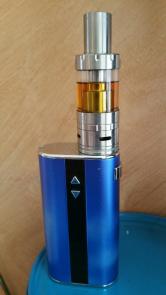Marijuana Derivatives: New Trend in Consumption and Purchase

Image of one type of vaporizer, a legal electronic device used to smoke (legal)flavored liquids
Detectives of the Street Crimes Unit, of the Fairfax County Police Organized Crime and Narcotics Division, have seen a trend in the past year involving a potent derivative of marijuana resin, particularly among high school students and young adults. The resin that is extracted from the marijuana plant, commonly referred to as “hash” or “hash oil,” can be prepared into various highly concentrated forms and textures, ranging from an oily or waxy substance to a hard, glass-like substance. Various street names often reflect its particular appearance or consumption method. There are many but common names include: BHO (Butane Honey Oil), Wax or Earwax, dab or dabs, budder/butter, crumble, honeycomb, pull, snap, 710 (OIL upside down) and Shatter.
Shatter is a hard form marijuana derivative and has an extremely high tetrahydrocannabinol (THC) content; THC is the active chemical compound in the cannabis plant. Marijuana derivatives can range from 40 to 80% THC concentration levels. Non-concentrated THC levels are typically 20%, according to the U.S. Department of Justice Drug Enforcement Administration’s Drugs of Abuse 2015 edition Resource Guide. Common reported side effects of this highly concentrated compound include hallucinations, confusion, panic attacks and even violent behavior.
Shatter and other marijuana derivatives can be inhaled through e-cigarettes and vaporizers (commonly referred to as “vape” or “vaping”). These electronic smoking devices often make the substance virtually smokeless and odorless; a big change from the common perception of big smoke clouds and distinct odor of burning marijuana. Additionally, the days of meeting your local supplier on the street corner have been replaced by ordering illegal drugs online and anxiously waiting for the package to arrive in the mail. Detectives regularly work with the U.S. Postal Service in these types of investigations.
If you have teenaged or college-aged children, we encourage you to talk to them about the dangers and risks of drug use. Be aware of newer methods of buying and receiving drugs and keep an eye out for the following behavior:
- Monitor the mail; Does your son or daughter seem anxious for it to arrive on a particular day or week?
- Monitor your son or daughter’s Internet and phone communication
- Look for signs and symptoms of drug intoxication
- Research trending drugs and related information
- Report any suspected involvement or activity to police
- Talk to a School Resource Officer (SRO) and/or encourage your high school-aged kids to talk to an SRO about drug abuse or trending drugs and related activity
Marijuana wax/oil is considered a Schedule I narcotic under the Drug Control Act. This means it has high potential for abuse and no currently accepted medical use. Possession of a Schedule I drug (VA State Code 18.2-250) or possession with intent to distribute a Schedule I drug (VA State Code 18.2-248) are both felony offenses.



